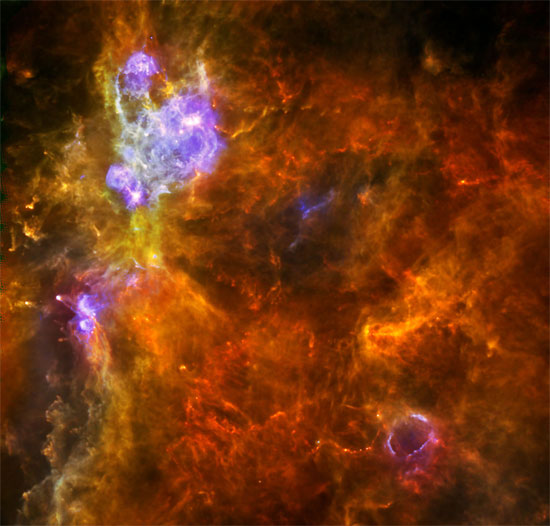Giant stars are created from 'star nursery'.
Newly born stars can grow up to 10-100 times the weight of the sun, if they are created in 'star nurseries' surrounded by many older stars.
'Star nursery' is a way to call a molecular cloud around the process of forming massive stars with a major component of H 2 , which is 1,000 to 100,000 times the mass of the sun or a few percent smaller. with the sun.
This finding has just been published in the Astrophysical Journal and on the ArXiv.org website, which helps explain why there are stars eight times more massive than the solar mass that can exist, despite astronomical models. Learning shows that it is impossible.
'This observation can uncover the curtain of the formation of the biggest stars so far that is still a mystery , ' said Dr. River Ingraham, the lead researcher as a graduate student at the school. University of Toronto said.
All stars are born in giant cloud of gas molecules and dust. A young star that is heavy enough will activate nuclear fusion and make itself shine. At that time, they started creating stellar winds.
The winds will blow away any remaining gas and dust, preventing the stars from continuing to accumulate mass, thus limiting its size.'Radiation in the birth of massive stars is very intense and it tends to destroy, push away the materials it needs to grow more,' said Rivera Ingraham at the Institute of Animal Research Astronomical physics and planets in France said.

The biggest stars are born surrounded by other big stars at the heart of Westerhout 3.
Rivera Ingraham and colleagues used high-resolution images from the European Space Agency's Herschel Space Telescope to study star formation in a cloud of gas and dust called Westerhout 3 , located 6,500 light-years away from the earth.
They examined clouds in long-range wavelengths and infrareds, mapped dust and temperature densities, searched for areas where the densest dust was the densest and protected from radiation. These are areas where new stars are born.
The team found that the densest part of the cloud is surrounded by a constellation of massive stars. They believe that stellar winds from stars block gas and dust from newborn stars. This gas and dust, if approached, will allow stars to accumulate larger volumes in a process known as convergent construction .
The researchers also said that blocking this effect could also provide the initial compressive force of molecular gas and cloud of electrical dust needed to burn star-forming processes in the first place.
They argue that each generation of these stars can create, the right conditions for the next generation of stars to grow relatively or even more around it, eventually leading to the formation of a rare cluster of massive stars.
Astronomer, Dr. Maria Cunningham, from the University of New South Wales, said this was a 'startling' discovery. 'We searched for young stars at the edge of clusters, not the center,' said Ms. Cunningham, 'But this is evidence that the age of star formation decreases as it gets closer to the center of a cluster '.
'It explains why we see mass stars clustered together, and why there are so few massive stars compared to other stars,' Ms. Cunningham explained, 'If the clusters are not it is only necessary for the creation of stars, but also for the formation of big stars, this will make all these beginnings meaningful. '
- Travel to the 'star nursery' 160,000 light-years from Earth
- How are stars created?
- Discovering the 'twin brothers' of the Sun, the prospect of the second Earth is no longer far away?
- The terrible secret of giant red stars
- Nursery star glowing
- Sparkling colors of the nebula
- Discovering a strange ring around the super star Kappa Ori
- The new discovery of a star is said to be a giant structure of aliens
- Deadly giant stars swallow their companions
- Detects 5 oversized stars on galaxies
- Stars are abandoned
- Brown stars don't go with normal stars
 Van Allen's belt and evidence that the Apollo 11 mission to the Moon was myth
Van Allen's belt and evidence that the Apollo 11 mission to the Moon was myth The levels of civilization in the universe (Kardashev scale)
The levels of civilization in the universe (Kardashev scale) Today Mars, the sun and the Earth are aligned
Today Mars, the sun and the Earth are aligned The Amazon owner announced a secret plan to build a space base for thousands of people
The Amazon owner announced a secret plan to build a space base for thousands of people NASA discovers two stars colliding so violently that they created gold
NASA discovers two stars colliding so violently that they created gold  James Webb Telescope Discovers Massive Supercluster Hidden Deep in the Milky Way
James Webb Telescope Discovers Massive Supercluster Hidden Deep in the Milky Way  'Time travel' 13.5 billion years, NASA telescope finds 4 cosmic ancestors
'Time travel' 13.5 billion years, NASA telescope finds 4 cosmic ancestors  Why there are no stars in American photos of the Moon
Why there are no stars in American photos of the Moon  Aliens control the fastest moving stars in the galaxy?
Aliens control the fastest moving stars in the galaxy?  First 'hybrid' star and planet object revealed outside the Milky Way
First 'hybrid' star and planet object revealed outside the Milky Way 